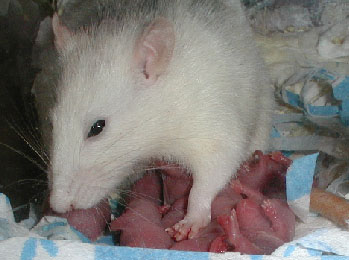|
|
|
Owing its name to the sledge dogs of artic regions this strikingly marked rat with unusual silvering coat has been in the U.K. for about 3-4years. Its origins are unclear, it is thought that it comes from Europe or possibly Russia. The rat itself has an even shape blaze that carries on to a thick line down its back. Viewed from the side a husky rat should appear to have even amounts of white and the top coat colour. Its underneath is all white and their eye colour should correspond to the top colour.
A black husky rat kitten with fur will have full markings that are an off black (not really yet black), at this age it may also have a pied tail and ears (black and white). This coat colour will then change to mid grey/blue with age and then to a lighter blue. During these stages the young rats coat will start to silver or wolf this involves the whitening of hairs especially around the face/blaze and the base of the tail, eventually the coat should be made up of a mixture of dark and white hairs much like a blue roan horse and the ears and tail should be pink/white, its eyes will be black.
A banded Husky kitten compared to an adult Husky rat.
The silvering is caused by a recessive gene and varies for each individual rat. It is almost impossible to predict. For example some individuals maybe quite dark where as others maybe almost completely white.

Above an almost white Banded Husky doe nursing.
Like the dog, Husky rats could be bred in all colours however light colours are not as effective as once they start to silver they would not provide much contrast
.The banded husky is shown under the name of "Striped roan" and below is the national fancy rat standard for a striped roan:
The National Fancy Rat Society Standard of Excellence
Striped Roan (banded husky): A strikingly marked bi-colour variety with
roan colouration, symmetry and contrast being important impressions. Clearly
distinct from existing marked varieties. Pattern: The striped
Roan shall have as symetrical markings as possible. The chest, belly,
sides and all the legs to be completely white. Head: A wide
inverted V shaped blaze including the whisker bed, coming as close to the eyes
as possible without touching the eyes, and coming to a point between the ears.
Jaw line and underside of the head must be white. Eye color to conform to
the standard for the base colour. Body: From the head, the
colour runs back covering the ears and continues along the body with no
suggestion of a hood, in an unbroken horizontal stripe, symetrical and as
straight as possible. The stripe to be approximately 5cm wide.
Demarcation shall be as clear cut and even as possible. Tail:
Unmarked preferred. Faults: White spots in coloured fur/coloured
spots in white fur. Brindled demarcation line, demarcation line too low.
Lack of white on face or a completely white face. Stripe too narrow or
broken, any suggestions of a hood.
|
Top Colour |
25 |
|
Belly Colour |
10 |
|
Demarcation |
10 |
|
Tail |
05 |
|
General conformation |
50 |
|
Total |
100 |
* This page is still under construction.*
Last updated
2nd November 2001.
This page was created with thanks to Ben for helping me with the kitten photo, Don of Arrencrest rattery for the photo of Spice, the NFRS for the Standard of the Striped Roan and Lian Vince from Rowangate Stud for help with the Standard.
All photo's and some art work are produced by me, unless stated otherwise. When taking any of my own work for your web site then please acknowledge me by either including me as a link or adding my banner (which is on the links page) :o)
Disclaimer = I do not claim to be an authority on rodents or rats and any information on this page is just opinions and advice and is by no means a substitute for good books or veterinary advice. All the toys on the toys page are just ideas and may not have been tried out so it is up to you to implement them and judge there safety.